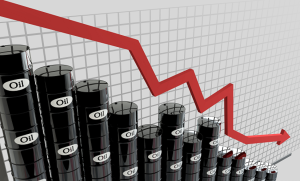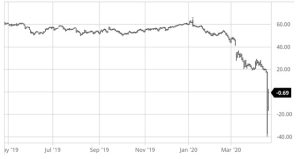 “A physical commodity will never go to zero,” I learned this old adage very early in my career when i joined the energy industry and it always held good, at least till today.
“A physical commodity will never go to zero,” I learned this old adage very early in my career when i joined the energy industry and it always held good, at least till today.
Faizan Shah Malik
AS some us went to sleep last night, Oil was trading at around $18.0 a barrel and when we woke up the price flashing on our TV screens was in the range of -$25 to -$35 per barrel. Yes, you read that right. -$37.63 is where the price of May Oil futures settled on the NYMEX (New York Mercantile Exchange).
The benchmark WTI (West Texas Intermediate) Oil that trades on the NYMEX and has become synonymous with Crude Oil around the world, traded as low as -$40.32 before settling at -$37.63 a barrel for the day.
History was created today, on Monday, April 20th as the world witnessed for the first time a negative price on Oil.
Price fell in excess of $55.0 a barrel from the previous day’s close. It was a monumental collapse. It is hard to fathom something of this magnitude.
The irony aside of this whole debacle, the whole ride down sounds pretty stupendous not to mention bewildering and quite mind-boggling.
How could it be? How can price of a commodity become negative?
A lot of you out there must be scratching your head and thinking the same and you wonder how is this possible?
Here is the explanation:
The price that you see and constantly hear on the news when they talk about Crude Oil, is the Futures price.
A contract to buy or sell something at a predetermined price at a specified time in the future.
The price in question here is the price for May Futures contract (Financial transaction) that needs to be offset on or before the expiry date (21st April for the May contract) and if one cannot offset it by the expiry date, then one has to take delivery of physical Oil.
If you take delivery, you have to then store the Oil somewhere, and it costs money to store this Oil.
During the last month or so as prices stated to fall, global storages started to fill up, and they began to fill up faster than anyone could have envisioned. Now as Oil was getting cheaper and cheaper, companies continued to store this “relative cheap Oil” and filled up storages.
And the ones that still had some space were so expensive that people found it cheaper to pay the buyer to take the delivery rather than pay for the exorbitant storage charges.
Since storages are now almost full and there is no place to store the new Oil, the price starts to fall quickly and since this May Futures contract expires on 21st April, you have very little time to get out of the position, otherwise you will have to take delivery and store the Oil and with no storages available, that is a risk not many people are willing to take.
So the price on this May contract starts to fall a lot faster than the other further out futures contract months like June, July et cetera.
So if you bought May Oil futures, you are now stuck with them with no buyers and you want to get rid of the oil, you will have to pay someone to do so.
So that’s why you pay someone to take the oil, hence the minus sign.
Futures prices of the front three months settled on 20th April, as follows:
May: -$37.63 per barrel — expires on April 21st
June: +$20.43 per barrel —expires on May 19th
July: +$26.28 per barrel — expires on June 22nd

This debacle had in fact started a little while earlier, in March, when the price war started between Saudi Arabia and Russia, apparently on not agreeing to come to a production cut to prop up prices and ended up deciding to flood the market with more Oil, which in itself is counter intuitive.
That started it all.
The price had already started to come down even before the virus began to put the final nail in the coffin. The recent Corona Virus lockdown and the subsequent economic turmoil that followed put a significant damper on the demand for Oil and the prices started to come off further. (Economics 101) — “Supply and Demand”
The road ahead for Oil in the short term doesn’t seem too propitious.
With most countries across the world extending their lockdowns or stay at home orders, demand for Oil is not expected to go up any time soon.
OPEC plus agreement to cut production will only start from May. The agreement is set to take away 9.7 million barrels from the market, which is roughly ten percent of the global production but experts are estimating that demand has fallen more than 30 percent and hence those cuts won’t be enough to keep the price up.
While on one hand the Producers are pumping as much Oil as they can which is not helping ease the Oil glut either, storages on the other hand are getting filled up very quickly and that exacerbates the problem further.
With prices falling sharply, a lot of small independent Oil producers in the US are on the brink of bankruptcy now. This OPEC plus deal had given them some hope even though some people were sceptic, but now it seems even that slight sliver of hope has dwindled away. We should now see fresh round of bankruptcies in the Oil sector in the US. The falling prices will have an impact on the poor African and Latin American countries as well, who will have to face further economic challenges in an already tough situation.
Lower prices usually propel demand but we are now in an environment where until the epidemic threat is looming large, a prop up in demand is seen to be a distant possibility. The demand destruction because of the corona pandemic was sudden and immediate while the production cuts will take its effect slowly; we should prepare ourselves for lower prices and a rough road ahead.
Writer is MA in Economics & MBA from University of Texas, Arlington and has previously worked as an Oil Trader for Noble Group. He is currently working as a Freelance Investment Advisor, Futures & Commodities trader.
Follow this link to join our WhatsApp group: Join Now
Be Part of Quality Journalism |
Quality journalism takes a lot of time, money and hard work to produce and despite all the hardships we still do it. Our reporters and editors are working overtime in Kashmir and beyond to cover what you care about, break big stories, and expose injustices that can change lives. Today more people are reading Kashmir Observer than ever, but only a handful are paying while advertising revenues are falling fast. |
| ACT NOW |
| MONTHLY | Rs 100 | |
| YEARLY | Rs 1000 | |
| LIFETIME | Rs 10000 | |









